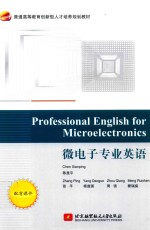图书介绍
微电子专业英语 英文版pdf电子书版本下载

- 陈显平主编 著
- 出版社: 北京:北京航空航天大学出版社
- ISBN:9787512417304
- 出版时间:2015
- 标注页数:210页
- 文件大小:87MB
- 文件页数:222页
- 主题词:微电子技术-英语
PDF下载
下载说明
微电子专业英语 英文版PDF格式电子书版下载
下载的文件为RAR压缩包。需要使用解压软件进行解压得到PDF格式图书。建议使用BT下载工具Free Download Manager进行下载,简称FDM(免费,没有广告,支持多平台)。本站资源全部打包为BT种子。所以需要使用专业的BT下载软件进行下载。如 BitComet qBittorrent uTorrent等BT下载工具。迅雷目前由于本站不是热门资源。不推荐使用!后期资源热门了。安装了迅雷也可以迅雷进行下载!
(文件页数 要大于 标注页数,上中下等多册电子书除外)
注意:本站所有压缩包均有解压码: 点击下载压缩包解压工具
图书目录
PART Ⅰ Basic knowledge of semiconductor physics and semiconductor devices 2
Chapter 1 Semiconductor 2
1.1 Early history of semiconductors 3
1.2 Properties and materials of semiconductor 4
1.3 Band theory of solids 6
1.4 Charge carrier(electrons and holes) 7
1.4.1 The carrier concentration 7
1.4.2 Carrier generation and recombination 7
1.4.3 Drift and diffusion current 8
1.5 Electrical conduction 9
1.6 Doping of semiconductor 10
1.7 Type of semiconductor 10
1.7.1 N-type semiconductor 10
1.7.2 P-type semiconductor 11
1.8 Questions 12
1.9 References 12
Chapter 2 Semiconductor devices 13
2.1 PN junction 14
2.1.1 Basic structure of the PN junction 14
2.1.2 Unbiased PN junction 15
2.1.3 The current-voltage characteristic of PN junction 16
2.1.4 The breakdown of PN junction 16
2.1.5 Junction capacitance 17
2.1.6 The applications of PN junction 18
2.2 Schottky diode 19
2.2.1 The structure of Schottky diode 19
2.2.2 The principle of Schottky diode 19
2.2.3 The characteristics of Schottky diode 20
2.2.4 The applications of Schottky diode 20
2.3 Heterojunction diode 21
2.3.1 The concept of heterojunction 21
2.3.2 The characteristics of heterojunction diode 22
2.3.3 The application of heterojunction diode 23
2.4 Bipolar junction transistor(BJT) 24
2.4.1 The basic structure of BJT 24
2.4.2 The current transfer characteristic of transistor 25
2.4.3 Basic configurations and modes of operation 26
2.4.4 The application of transistor 27
2.5 The MOS transistor 28
2.5.1 The basic structure of MOS transistor 28
2.5.2 The form of inversion layer of MOSFET 29
2.5.3 The basic operation and DC characteristic of MOSFET 29
2.5.4 The types of MOSFET 31
2.5.5 The terminal capacitances of MOSFET 32
2.5.6 The advantage and application of MOSFET 33
2.6 Questions 34
2.7 References 35
PART Ⅱ Manufacturing technologies and processes 38
Chapter 3 Doping technology and hot processing 38
3.1 Doping 39
3.1.1 Diffusion 40
3.1.2 Ion implantation 41
3.1.3 Idealized ion implantation systems 42
3.1.4 Channeling effects 44
3.1.5 Shadowing effects 45
3.1.6 Ion implantation damage 46
3.2 Thermal oxidation 47
3.3 Rapid thermal processing(RTP) 50
3.3.1 RTP configuration and chamber design 52
3.3.2 Rapid thermal activation of impurities 54
3.3.3 Rapid thermal processing of dielectrics 55
3.4 Questions 57
3.5 References 57
Chapter 4 Pattern transfer 58
4.1 Photolithography 60
4.2 Photoresist(PR) 61
4.2.1 Composition of PR 61
4.2.2 The types of PR 61
4.2.3 The contrast curve of PR 61
4.3 The pre-exposure process 62
4.3.1 Priming 63
4.3.2 Photoresist coating 63
4.3.3 Soft bake 65
4.4 Alignment and exposure 66
4.4.1 Printer 66
4.4.2 Photomask fabrication 67
4.4.3 Alignment 69
4.4.4 Exposure 71
4.5 Postexposure 72
4.5.1 Postexposure bake 72
4.5.2 Development 73
4.5.3 Hard bake 75
4.5.4 Pattern inspection 76
4.6 Nonoptical lithographic techniques 77
4.6.1 X-ray lithography(XRL) 77
4.6.2 Projection X-ray lithography 78
4.6.3 Electron beam lithography(EBL) 79
4.6.4 Projection electron beam lithography(SCALPEL) 80
4.6.5 Ion beam lithography 81
4.6.6 EBL and XRL resist 82
4.7 Etch 82
4.7.1 Introduction 82
4.7.2 The characteristic of etch 83
4.7.3 Wet etch process 85
4.7.4 Chemical mechanical polishing(CMP) 86
4.7.5 Dry etching 87
4.8 High density plasma(HDP)etching 92
4.9 Liftoff 92
4.10 Questions 93
4.11 References 94
Chapter 5 Thin film 95
5.1 The introduction of thin film 96
5.1.1 Metallic thin films 98
5.1.2 Polysilicon 99
5.1.3 Oxide and nitride thin films 99
5.2 Physical vapor deposition 100
5.2.1 Evaporation 101
5.2.2 Sputter 103
5.3 Chemical vapor deposition 104
5.3.1 Chemical vapor deposition process description 104
5.3.2 Classification of CVD reactors 104
5.3.3 Atmospheric pressure CVD 106
5.3.4 Low pressure CVD in hot wall systems 107
5.3.5 Plasma-enhanced CVD 107
5.3.6 Step coverage 108
5.4 Epitaxial growth 110
5.4.1 Homoepitaxy 111
5.4.2 Vapor phase epitaxy 111
5.4.3 VPE hardware 112
5.4.4 Epitaxy process 114
5.4.5 Selective epitaxial growth 115
5.4.6 Heteroepitaxy 116
5.4.7 MBE 117
5.4.8 MOCVD 118
5.5 Questions 119
5.6 References 120
Chapter 6 Process Integration 121
6.1 CMOS 122
6.1.1 Introduction 122
6.1.2 The formation of the CMOS process 123
6.2 Microelectromechanical system(MEMS) 126
6.2.1 Introduction 126
6.2.2 The types and advantages of MEMS 128
6.2.3 The processes of MEMS 129
6.3 Nanoelectromechanical system(NEMS) 136
6.4 Questions 136
6.5 References 137
PART Ⅲ Frontiers of science and technology 140
Chapter 7 More than Moore:creating high value micro/nanoelectronics systems 140
7.1 Introduction 140
7.2 Preconditions for an industry-wide technical roadmap 146
7.3 Lessons learned from“More Moore” 147
7.3.1 Metallic nanowires 147
7.3.2 Combining focus and variety 148
7.4 Proposed methodology for“More-than-Moore” 148
7.5 Applying the proposed methodology 150
7.5.1 Form societal needs to markets 150
7.5.2 MtM devices 152
7.6 Summary 157
7.7 References 157
PART Ⅳ Development of professional English ability 160
Chapter 8 How to write a scientific paper 160
8.1 What is a scientific paper? 161
8.1.1 The structure of a paper 161
8.1.2 Steps for writing a paper 161
8.2 Searching information in databases 163
8.2.1 Web of Science 163
8.2.2 Google Scholar 170
8.3 How to prepare the Title 172
8.4 How to prepare the abstract 173
8.5 How to write the Introduction 175
8.6 How to write the Materials and Methods section 178
8.7 How to write the Results 181
8.8 How to write the Discussion 182
8.9 How to state the Acknowledgment 183
8.10 How to cite the Reference 185
8.11 Questions 191
8.12 References 191
Chapter 9 How to make a successful presentation 192
9.1 Attention curve 192
9.2 How to make a great PowerPoint presentation 194
9.2.1 Create your narrative 194
9.2.2 Utilize the format 197
9.3 How to prepare an oral presentation 206
9.3.1 Before your presentation 206
9.3.2 During your presentation 207
9.3.3 Warnings for oral presentation 209
9.4 Questions 209
9.5 References 210